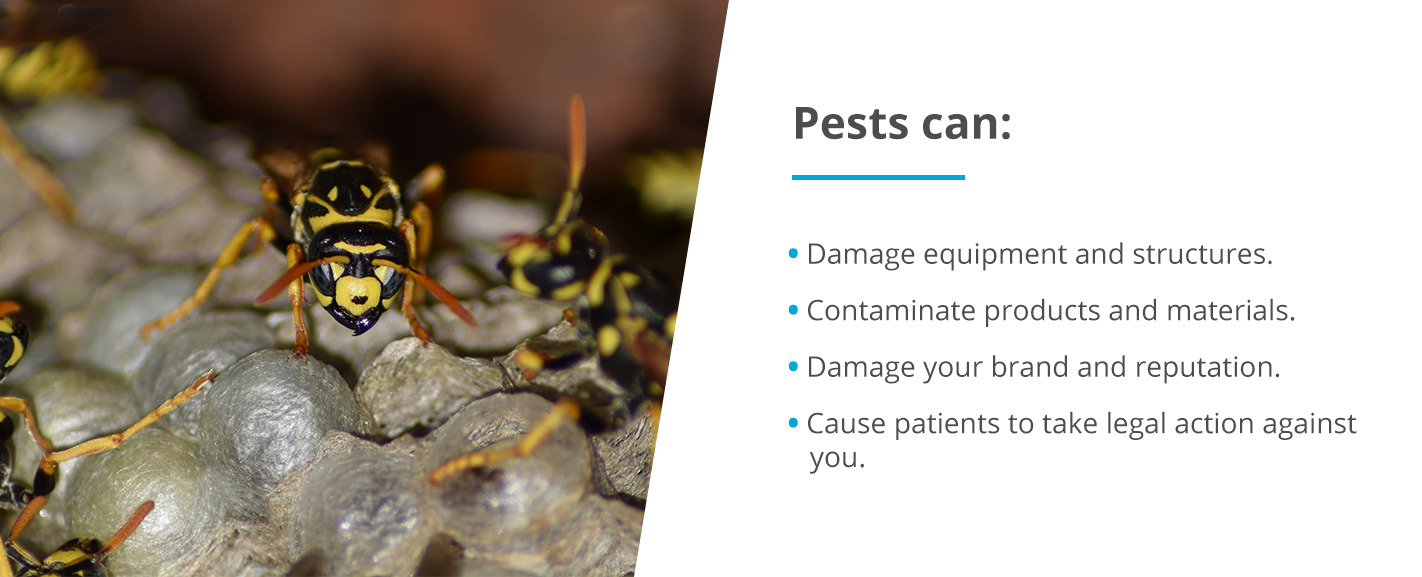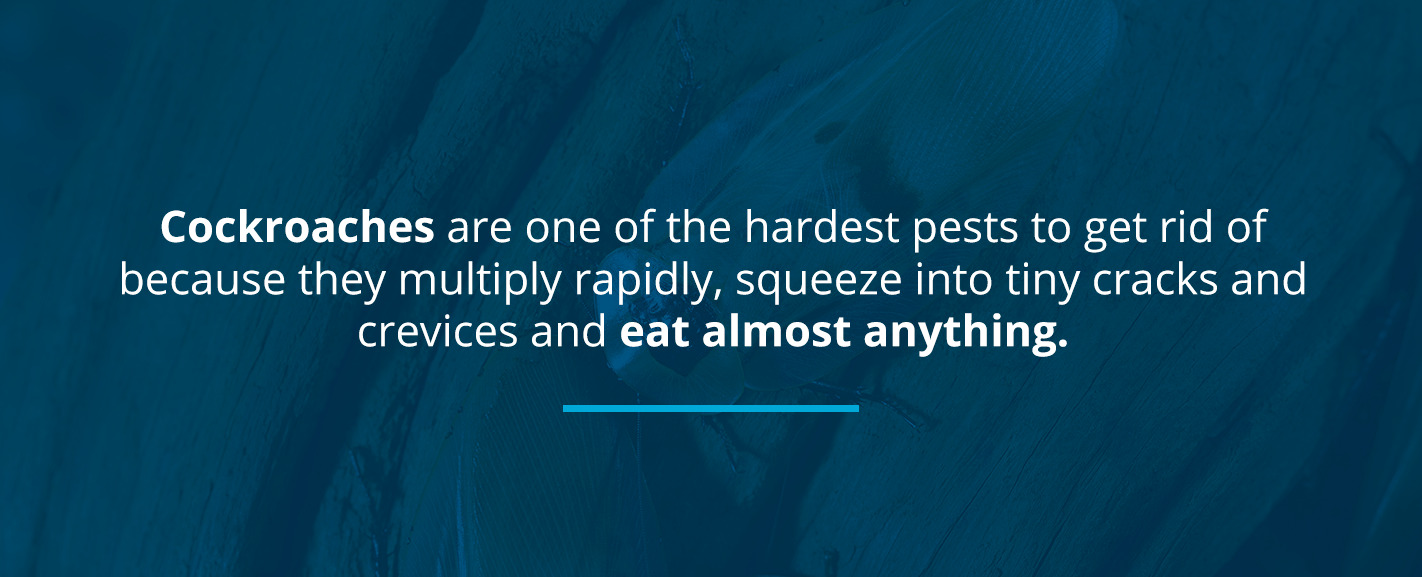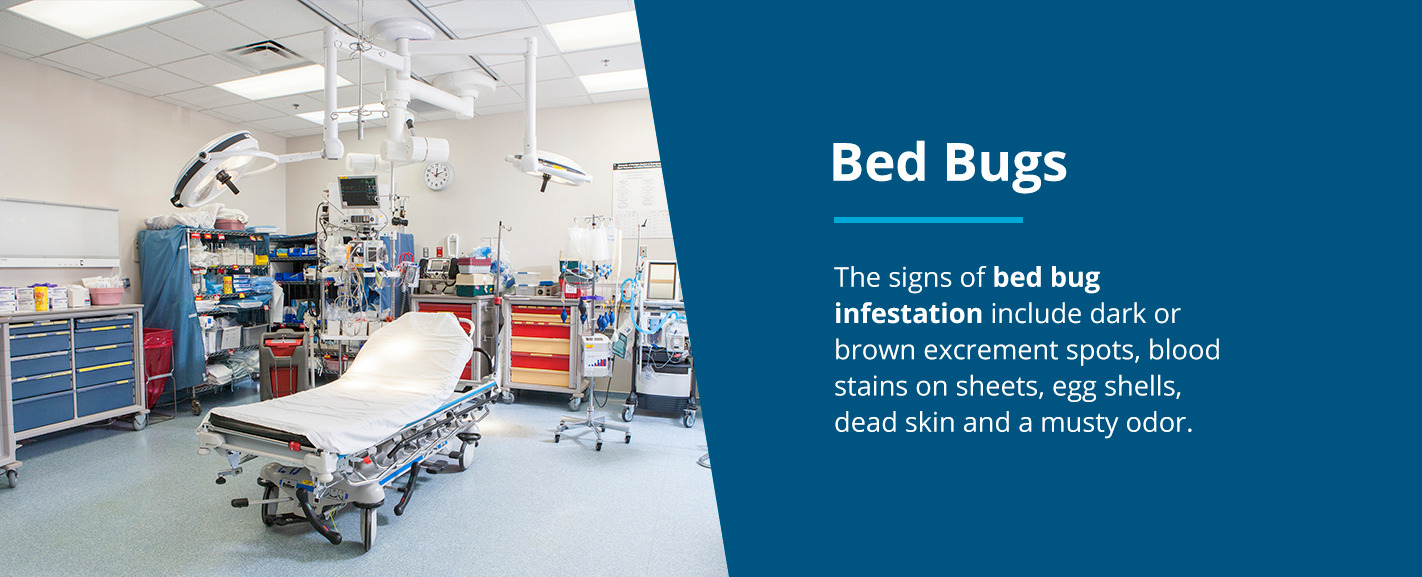How to Control Pests in Hospitals and Health Care Facilities
 Hospitals and health care facilities must maintain high levels of sanitation and cleanliness to prevent the spread of pathogens and keep patients and workers safe. Employees and patients are at risk of contracting diseases without proper sanitation, which can lead to patient health complications during treatment.
Hospitals and health care facilities must maintain high levels of sanitation and cleanliness to prevent the spread of pathogens and keep patients and workers safe. Employees and patients are at risk of contracting diseases without proper sanitation, which can lead to patient health complications during treatment.
Pests are a dangerous threat to medical facility sanitation and a top spreader of diseases. They can:

- Damage equipment and structures.
- Contaminate products and materials.
- Damage your brand and reputation.
- Cause patients to take legal action against you.
Effective pest control services for hospitals and health care facilities are the best way to prevent this. This guide reviews the causes of pests in health care facilities, the most common ones and what you can do to stop them.
Causes of Pests in Health Care Facilities
Pests enter health care facilities from within the structure or through the items brought in by staff and visitors, such as flowers, food and clothing. During winter, pests move indoors. Rodents enter through utility openings, loading dock doors or vegetation like trees and shrubs close to the building.
Leaking pipes attract flies, cockroaches or other pests that like excess moisture and give them an entry point. Another easy access point for insects is through uninspected food deliveries. The cardboard boxes the deliveries come in provide shelter for pests if they aren’t disposed of properly. Clothes, bags and purses can bring in pests like bed bugs, and laundry collection can spread them.
The Most Common Pests in Health Care Facilities
While any pest can invade health care facilities, the most common ones are cockroaches, rodents, ants, flies, birds and bed bugs. These pests spread diseases and contaminate equipment, supplies and surfaces. Even if you don’t see pests, that doesn’t mean they aren’t there. Knowing basic information about them and signs of infestation will help you and your staff spot potential problems early.
Cockroaches

Cockroaches are so common that they are easily identifiable. Unfortunately, they are one of the hardest pests to get rid of because they multiply rapidly, squeeze into tiny cracks and crevices and eat almost anything, whether old food or fecal matter. Due to their diet, they carry a range of bacteria and viruses that can cause salmonellosis, leprosy, cholera, typhoid fever and dysentery.
The signs of a cockroach infestation include dark or golden smears along walls, floors and other surfaces, an unpleasant, musty odor, droppings that look like soil or coffee grounds, cockroach skins, tiny chew marks on belongings and egg capsules with 8-20 segments.
Rodents
Rodents chew through almost anything and frequently defecate, contaminating numerous surfaces. They are one of the most common pests in New York, especially during winter. Mice and rats can spread more than 35 diseases. These pests can enter buildings through small cracks and openings.
Signs of rodent infestation include squeaking and scurrying sounds at night, droppings, bite and grease marks and chewing damage.
Ants
Ants easily enter any building because of their small size. While not known to spread diseases, they still contaminate food sources and surfaces. Since they are colony insects, one ant indicates many.
Signs of an ant infestation include food crumbs or debris, usually in a line, wood shavings, damp or rotting wood, soft rustling inside the walls, small piles of dirt or sand and regular sightings of ants.
Flies
House flies and fruit flies are common in New York and have spread at least 65 diseases to people. Flies feed on food and garbage, and when they land, they regurgitate and excrete, transmitting any organisms they’ve picked up.
If you have a fly infestation, you might notice flies regularly buzzing around garbage, evidence of debris and damage caused by insects and insect body parts.
Birds
Birds create unsafe conditions when droppings or debris and nesting material collect on stairways. Additionally, they are known to carry over 60 diseases. Sites with water, food, shelter, nesting and loafing attract birds.
Aside from seeing birds, signs of infestation include droppings, nests, bird eggs and chirping.
Bed Bugs

Bed bugs are challenging to exterminate because they reproduce quickly and are small enough to squeeze into tight places. While not known to spread diseases, bed bugs can cause itchy, red welts on your skin. These bites can trigger allergic reactions and asthmatic symptoms. Infections may occur if you pick at them.
The signs of bed bug infestation include dark or brown excrement spots, blood stains on sheets, egg shells, dead skin and a musty odor.
Where Are Pests Found in Health Care Facilities?
While all areas of a hospital or health care facility are at risk for pests, some are more prone to infestations than others. For instance, cockroaches like dark, damp places, and flies like garbage. Here are the different pests and the areas they like that are at high risk for infestation:
- Cockroaches: Cockroaches are usually found in the locker and break rooms, janitorial closets, food service areas, restaurants, laundry areas, snack bars, vending machine areas, floor drains and sink areas, intensive care units (ICUs), autopsy rooms, loading docks, kidney dialysis rooms, basements and garbage disposal areas.
- Rodents: Rodents are common in laundry areas, food carts, food service areas, basements, loading docks and garbage disposal areas.
- Ants: Ants prefer laundry areas, ICUs, kidney dialysis rooms and autopsy rooms.
- Flies: Flies can be anywhere, especially in food service areas, food carts, ICUs, surgical suites, laundry areas, autopsy rooms, loading docks and garbage disposal areas.
- Birds: Birds like rooftops near HVAC units and air ducts.
- Bed bugs: Bed bugs are found in patient room beds, waiting area furniture and laundry areas.
These areas require vigilance when looking for signs of infestation, but pests can be anywhere. It is a good practice to regularly check all areas of the facility for rodents, insects and other animals.
Pest Control Checklist for Hospitals and Health Care Facilities
Pest infestations are a significant problem for anyone, but especially hospitals and health care facilities. In the medical industry, they spread diseases and contaminate surfaces, inhibiting patient recovery and infecting staff and visitors. It’s better to prevent a pest infestation instead of controlling one. Luckily, there are several steps you and your employees can take to prevent them.
Educate Staff
Hospitals and medical facilities are large and have complex organizational systems, so it is essential to educate all levels of staff and coordinate with an experienced pest management service. Due to the nature of medical facilities, pest control needs to fit your specific needs. An integrated pest management (IPM) program combines pesticide applications with green and organic solutions. IPMs eliminate pest problems and prevent future issues with little environmental impact.
IPMs focus on finding the best treatment for pest problems, not the easiest. The process for Pestech’s four-step IPM is:
- Set an action threshold: Our expert technicians inspect the building to know how severe the infestation is and what level of pest control is required.
- Identify pests: To effectively treat your infestation, we must identify the pests. Each pest requires a different method of control. We can work to eliminate the pests once we know what kind they are.
- Control: We compare various pest control methods to determine which has the least environmental risk for the severity of the problem. Our experts use traps, biological pesticides and pheromones first. If necessary, they will use targeted synthetic pesticides or pesticide spray.
- Prevention: A long-term solution must include prevention, or you will never move past the control stage. Pestech’s prevention methods include sealing cracks, gaps and holes, identifying leaks and cutting off food and water sources.
When implementing an IPM, you must develop educational programs for your staff. Employees play an essential role in preventing pest infestations while they are on-site. All workers need to know how to recognize and report the signs of a pest infestation or sightings. By knowing what to look for and how to report it, staff can bring attention to infestations so you can control them before they worsen.
Staff needs to know pest behavior and biology. It makes it easier to prevent and control them. For instance, if staff know that bed bugs can attach to clothes and personal belongings, they can be vigilant when inspecting these items in laundry areas. To educate staff, facilities can distribute printed guides and materials, post flyers in break rooms and locker rooms and hold regular meetings and seminars to review the facility’s practices and policies.
Monitor Entrances
Without an entry point, pests couldn’t invade your hospital or health care facility. You must seal any cracks, gaps or holes in walls, floors or other surfaces. Open doors and windows allow flies and other pests to enter, so doors should be kept closed and contain door sweeps. Windows need screens, and utility openings need to be properly closed off.
Empty Trash Receptacles Daily
Many pests love garbage, especially rodents, cockroaches and flies. They like to hang around trash receptacles because they provide them with food and shelter. Pests can feed on food and other matter found in the garbage and hide inside bins and dumpsters. The best way to prevent this is to keep trash receptacles closed and empty them daily. Without any trash, the pests will have to go elsewhere.
Inspect Food Deliveries
Food deliveries are an easy access point for pests. When employees don’t properly inspect deliveries, the insects succeed in invading the facility. Therefore, it’s crucial to have established protocols regarding food deliveries and inspections.
A knowledgeable staff member must check for signs of pests or actual pests as soon as the delivery arrives. They must discard anything with pests. All cardboard boxes must be disposed of properly, or they will provide shelter to insects, rodents and other animals.
An employee must inspect stored food items at least twice a month. Pests like ants love to make themselves at home in dry pantry goods. Thus, keeping food items on shelves instead of the floor is best.
Maintain the Plumbing System
Plumbing systems with excess moisture attract pests like flies and cockroaches. Pipes with condensation or leaks and bathroom or sink drains with clogs can be problematic. It is essential to fix any leaky pipes or clogs and seal any entry points around pipes. This prevents a small problem from becoming more serious.
Clean All Surfaces Regularly
Hospitals and health care facilities should already have excellent sanitation practices in place. They are necessary to kill germs and decontaminate surfaces. Cleaning regularly also prevents pests. Pests are attracted to food debris and moisture, and excess clutter gives them a breeding ground. Ensuring places under appliances and shelves are clean effectively eliminates overlooked food and water sources.
Be Alert for Bed Bugs
Bed bugs are problematic and hard to control. They enter hospitals through clothes, bags and purses and infest furniture, bedding and laundry areas. If left unchecked, bed bugs will cause potential lawsuits, financial loss and discomfort for patients and staff. Ensuring your workers know how to identify bed bugs is the best way to prevent them.
These pests love to nest in soft, dark areas and materials, such as drapes, drawers or bedding. Routinely cleaning problem areas helps prevent infestations. To identify bed bugs, employees will need a magnifying glass, flashlight and informational pamphlet that shows pictures of the pests and their eggs.
Inspect the Outside of the Building
Regularly inspecting the outside of the building helps you notice areas that need repairs. Bugs and rodents may enter buildings through cracks, holes and gaps, so you must repair these quickly.
Rodents and other pests seek out buildings during colder weather. They usually enter through loading docks, utility doors or vegetation. When inspecting the outside, pay attention to any shrubs or trees close to the building. Trimming these helps prevent rodents from having easy access to upper levels, windows and the roof.
Get Routine Preventative Pest Control
Stopping pests before they become an infestation requires routine preventative pest control. The above methods help prevent pets, but only pest control can contain and control them. Regular inspections by pest control technicians alert you to any areas of concern before they become a problem. This allows you to focus on your patients, while pest management services focus on preventing pests.
Pest control for hospitals and health care facilities needs to be done with care. Environmentally friendly methods are combined with other preventatives to ensure the safety of your staff and patients.
Choose Pest Control Solutions From Pestech
At Pestech, we aim to find safe and effective ways to eliminate pests from your health care facility. We won’t use any methods that make you uncomfortable. Before we implement our integrated pest management solution for your health care operation, we will explain what we plan to do.
If you are concerned about the environmental impact, we offer a GreenPro Program. This program uses mechanical and targeted pest control methods to minimize environmental impact.
We can treat and prevent all of the pets commonly found in hospitals. Our services come with a 100% satisfaction guarantee. If we do not successfully eliminate the pest the first time, we will return as many times as it takes, free of charge. Contact us today to start your routine pest control services or schedule an inspection.

